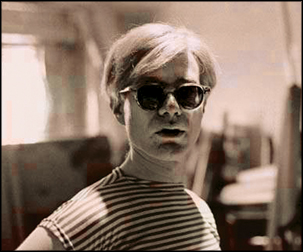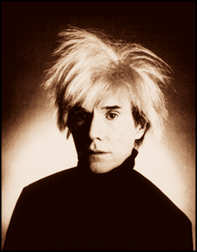|
"I did not shoot Andy Warhol" Part II:
'Everyone will be famous for 15 minutes'

 |
|
Andy Warhol |
After his June 3, 1968 shooting, a reclusive Warhol relinquished his
personal involvement in filmmaking. His acolyte and assistant director,
Paul Murrissey took over the filmmaking for the Factory. He took
Warhol-branded cinema towards more mainstream, narrative-based, B-movie
exploitation fare with Flesh, Trash, and Heat. All of these films,
including the later *Andy Warhol's Dracula *and *Andy Warhol's
Frankenstein*, were far more mainstream than anything Warhol as a
director had attempted. In the early 70s, most of the films directed by
Warhol were pulled out of circulation by him and the people around him
that ran his business.
Come to think about my neighbour in Lower east side on 3rd street
between C and D avenues, it was the Avant-Garde legendary "Living
Theater "group from the sixties. I used to go and hang there some times.
(They were just across the street from my apartment). Their plays were
way to Avant-Garde, I just didn't get them. But I found out Warhol used
to collaborate with them on some of the filmmakers who made some of
"Living Theater" productions into movies. The Living Theatre's
production of The Connection was filmed by Shirley Clarke in 1961. Their
production of The Brig was filmed in the early spring of 1964 by Jonas
Mekas. Both Mekas and Clarke were among the founders of the New American
Cinema Group. Both Shirley Clarke and Jonas Mekas were also involved in
distributing The Chelsea Girls.
Going back in time to my apartment in 3rd street in 1991, too many
stories untold. It was so fantastic the way how we found the apartment.
Myself Geoff, and Justin J, and later came Spencer Tunic (The
photographer). We were all roommates for a while. I used to have the
biggest parties down there. I always wanted it to be like Warhol's
studio. Even though it was not quite like that, we did have many things
happening there. We did have from parties to, film shoots to, slide
shows to, and pool competitions. This was way before my apartment in 2nd
Street between avenue A and B. Actually this was before even my first
film "Sihina Deshayen" (Veils of Maya). It was during the first Gulf War
in 1991. I learned that Warhol was a networking party person. If there
was a party Warhol was there, and he knew everyone.
He was an amazing networking personality. I wanted to be like him, be
like that. I think as a result of that, among my friends; I became the
biggest networking person. I was at almost every downtown party and
event. If it was an underground film screening, I would be there. If it
was a floating club like "The Deep", I would be there. If it was some
kind of an offbeat art opening, I would be there. Tunnel was a special
club that I used to hangout, and when Andy Warhol was alive, it was a
club that he went often too. ( I even went their myself with Martin Gore
of "Depeche Mode" once after a concert ). With this I started to get to
know more and more people. Some of them were celebrities, and some were
the cream of American intellectuals. I used to think whenever I met a
celebrity or got to hang out with them, that it was my "15 minutes of
Fame".
The expression is a paraphrase of Warhol's 1968 statement: "In the
future, everyone will be world-famous for 15 minutes." Warhol's comment
and the insight it expresses grew out of his own interest in fame and
celebrity. His view of the media was that they could enable any person
to become famous.
 |
|
Andy Warhol |
Warhol's own shifting entourage of otherwise undistinguished
hangers-on in the '60s and '70s, whom he dubbed his "Superstars,"
exemplified his idea of short-term, disposable celebrity. I think
today's reality TV such a American Idol, Sri Lanka's "Super Star" helps
Andy's theory become true. In 1979 Warhol reiterated his claim: "...my
prediction from the 60's finally came true: In the future everyone will
be famous for fifteen minutes." Becoming bored with continually being
asked about this particular statement, Warhol deliberately tried to
confuse interviewers by changing the statement variously to "In the
future 15 people will be famous" and "In 15 minutes everybody will be
famous." A more recent adaptation of Warhol's quip, possibly prompted by
the rise of online social networking, blogging, and similar online
phenomena, is the claim that "In the future, everyone will be famous to
fifteen people" (or, in some renditions, "On the Web, everyone will be
famous to fifteen people").
Andy Warhol dreamed of a television show that he wanted to call The
Nothing Special, a special about his favourite subject: Nothing. Later
in his career he did create two cable television shows, Andy Warhol's TV
in 1982 and Andy Warhol's Fifteen Minutes (based on his famous
quotation) for MTV in 1986.
Besides his own shows he regularly made guest appearances on other
programs, including The Love Boat In 1979, Warhol appeared as himself in
the film Cocaine Cowboys.
Warhol's photographic approach to paintings really effected and
influenced art scene all over the world. To produce his silk-screens,
Warhol made photographs or had them made by his friends and assistants.
These pictures were mostly taken with a specific model of Polaroid
camera that Polaroid kept in production especially for Warhol.
This photographic approach to painting and his snapshot method of
taking pictures has had a great effect on artistic photography. Warhol
was an accomplished photographer, and took an enormous amount of
photographs of Factory visitors, friends. Warhol was also friendly with
many recording artists, including Deborah Harry, Grace Johns, Diana Ross
and John Lennon, and he designed the cover to Lennon's 1986 Album.
Warhol also appeared as a bartender in The Cars' music video for their
single "Hello Again", and Curiosity Killed The Cat's video for their
"Misfit" single (both videos, and others, were produced by Warhol's
video production company).
|

